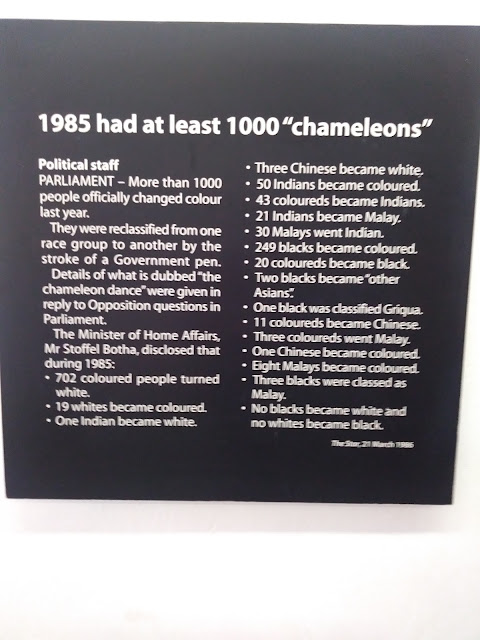Disclaimer: This is information that I synthesized from memory of various sources, including tours and visits to the Apartheid Museum, Constitution Hill, District 6 Museum, South African Museum, Groot Constantia Estate, South African Slave Church Museum, and more.
Meanwhile, the area that is now known as Johannesburg, was a grassy plain without any permanent settlement until gold was discovered in the late 1800s. Workers came from all over southern Africa, India, and other places to earn a fortune, that never came to fruition. The mine workers, including whites, lived in poor, unsanitary housing, and the mines were dangerous, deadly places. Slavery was officially over at that point, but gold mining, was essentially a form of sharecropping. The only benefactors were (still are) white, corporate owners.
Poor people of all races lived in the same slums. The urban areas needed the workers in order to be sustainable, but the whites in charge didn't want all the races mixed. They thought race mixing led to crime and disease, and a degrading of their "superior" race. They created a system known as apartheid (separateness in Afrikaans), state sanctioned/institutional segregation, where everyone was classified by race and was subject to certain laws based on their race affecting every part of their life. The classifications included black (native), white, colored, and Asian/Indian.
 |
| "A White person is in appearance White and not Coloured; A Coloured is a person who is not a White or a Bantu" |
 |
| "518 Colored persons were reclassified as White persons; 1 White person was reclassified as a Coloured person" |
Apartheid was official policy from 1948-1994, but there were forms of segregation in place prior to it being codified after the 1948 election. From the beginning of Dutch and British settlement, there were mixed marriages and sexual relations between whites and the black people, which created offspring who were neither black nor white. They were called, "colored". In the early 20th century, each person was given a passbook that identified their race and indicated where they could go. (Ghandi's passive resistance movement began in South Africa when he protested the passbooks.) The racial classification was subjective, and there were many cases of people changing from one race to another. Not only did they look at your skin complexion, but they also made assessments based on hair texture, facial features, family name, etc. The classification system was very confusing. The classifications split families and sowed distrust amongst the various groups.
I was told that in South Africa, you are considered colored if you have any white ancestor/white blood. In America, there's the "one drop rule". If you have a black ancestor/black blood, then you're considered black. According to South Africa, in my nuclear family, my mother and my brother would be considered colored, my father would be black, and I would probably sit on the fence. My skin complexion would put me in the "colored section", but my kinky hair would make me closer to black. As my friends explained this system to me, I asked them if I had a baby with Trevor Noah, South African comedian and host of The Daily Show, who has a black Xhosa mother and a white Swiss father, would our baby be black or colored. (Check out Trevor's video below.) One person said black and the other said colored. In America, we're all just black.

 |
| Apartheid's impact on prisoners |
Apartheid was a systematic approach to reinforce the supposed superiority of whites over everyone else. The irony is South Africa sent troops to fight the Nazis in World War 2. Although non-white South Africans protested the system for decades, the world paid little attention until the government started jailing, torturing, and sometimes killing children. Students from Soweto (South west township) rose up to demand justice and freedom, and they were threatened and attacked by the police in return. Sarafina!, one of my favorite movies, tells the story of the Soweto protests and the punishment inflicted on innocent children and families. There were also calls to free the world's most famous political prisoner, Nelson Mandela. The world started paying some attention when global citizens demanded that companies and governments divest from South Africa in the 1980s.
The South African government was slowly coming to terms with the fact that the violence and war on the people was unsustainable, and negotiations began to take place for a transition. South Africa's democratic election of 1994 brought about a repeal of apartheid laws and Nelson Mandela was elected as President of the new South Africa. Things did not change overnight. Legal segregation was the law for nearly 100 years, and ended less than 25 years ago. That was in my lifetime! Some people believed that the transition to a black President would mean that white people would receive blanket punishment and would be subject to revenge. Instead, Mandela sought peaceful relations and tried to mend the country's deep divisions. The new South African constitution was written to be inclusive of all people, regardless of race, gender, sexual orientation, religion, income, etc.
Archbishop Desmond Tutu led the Truth and Reconciliation Commission, which focused on restorative justice. The TRC allowed victims and witnesses to tell their stories publicly, and perpetrators also testified to their crimes with the hopes of receiving amnesty. Instead of sweeping decades of oppression and violence under the rug, South Africa shed light in those dark places to bring about healing. People are still learning to live together peacefully and overcome the challenges of apartheid.

 |
| Nobel Square: South Africa's Nobel Peace Prize winners - Chief Lethuli, Archibishop Desmond Tut, F.W. DeKlerk,Nelson Mandela |








No comments:
Post a Comment